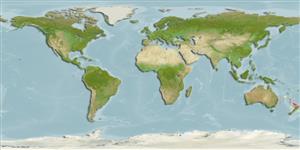>
Aulopiformes (Grinners) >
Paraulopidae (Cucumber fishes)
Etymology: Paraulopus: Paraulopus refers to a taxon related to Aulopus, both being included in the Aulopiformes.
Eponymy: Dr Osamu Okamura was Professor Emeritus at the Laboratory of Natural Science, Kochi University, where he was Professor of Zoology (1989). [...] (Ref. 128868), visit book page.
Environment: milieu / climate zone / depth range / distribution range
Ecologia
marinhas batidemersal; intervalo de profundidade ? - 478 m (Ref. 46206). Deep-water
Southwest Pacific: north of New Zealand.
Tamanho / Peso / Idade
Maturity: Lm ? range ? - ? cm
Descrição suscinta
Chaves de identificação | Morfologia | Morfometria
Raios anais : 9 - 11. This species is characterized by the following: A 9-11, rarely 9; pectoral fin rays 16-17; black-and-white-patterned dorsal and caudal fins; side of the body of adults with small brown blotches midlaterally and a smaller brownish saddle behind the adipose fin; interior of the mouth entirely pale (Ref. 86263).
Minimum depth from Ref. 58018.
Ciclo de vida ou comportamento de acasalamento
Maturidade | Reprodução | Desova | Ovos | Fecundidade | Larvas
Eschmeyer, W.N. (ed.), 2003. Catalog of fishes. Updated database version of March 2003. Catalog databases as made available to FishBase in March 2003. (Ref. 46206)
Status na Lista Vermelha da UICN (Ref. 130435: Version 2024-2)
Ameaça para os humanos
Harmless
Uso pelos humanos
Ferramentas
Relatórios especiais
Baixar XML
Fontes da internet
Estimates based on models
Preferred temperature (Ref.
123201): 12.2 - 16, mean 13 °C (based on 6 cells).
Índice de diversidade filogenética (Ref.
82804): PD
50 = 0.5001 [Uniqueness, from 0.5 = low to 2.0 = high].
Bayesian length-weight: a=0.00389 (0.00180 - 0.00842), b=3.12 (2.94 - 3.30), in cm total length, based on all LWR estimates for this body shape (Ref.
93245).
Nível Trófico (Ref.
69278): 3.9 ±0.7 se; based on size and trophs of closest relatives
Fishing Vulnerability (Ref.
59153): Low vulnerability (12 of 100).
